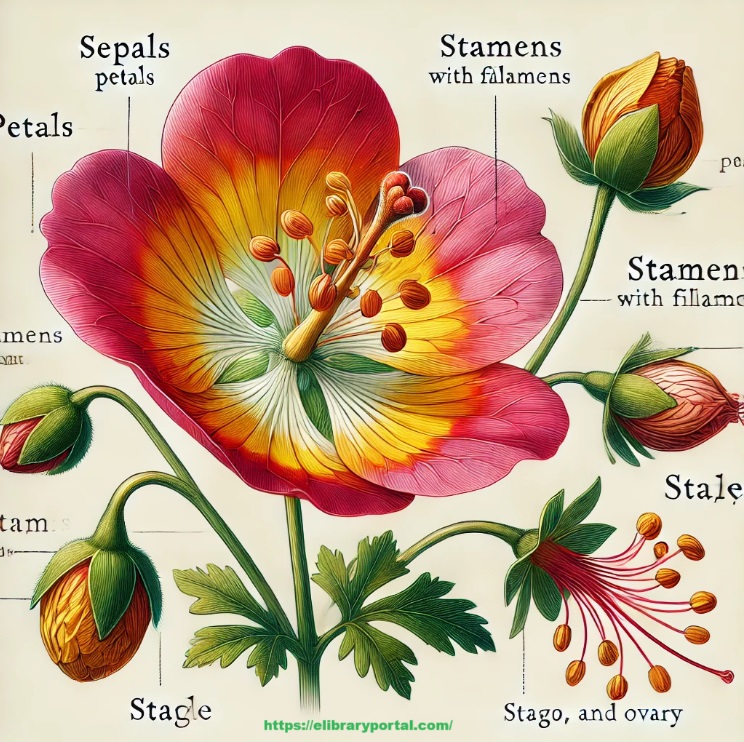The flower is one of nature’s most remarkable structures, functioning as the reproductive organ in angiosperms (flowering plants). Flowers exhibit an extraordinary variety in terms of form, color, size, and function, all of which have evolved to facilitate sexual reproduction. The process by which flowers enable the continuation of a species is both complex and elegant, involving a combination of pollination, fertilization, and seed production. This essay will explore the anatomy, functions, and significance of flowers in the reproductive cycle of flowering plants, delving into how they ensure the propagation and survival of angiosperms.
1. Introduction to Angiosperms
Angiosperms, or flowering plants, represent the most diverse group in the plant kingdom, with over 300,000 species spread across different ecosystems. They dominate terrestrial ecosystems and play a vital role in food production, carbon cycling, and maintaining biodiversity. The key to their dominance lies in the unique reproductive strategy centered around flowers, which are specialized structures designed for sexual reproduction.
Flowers are not merely ornamental structures; they serve as the sites where essential reproductive processes such as pollination and fertilization occur. Understanding the structure and function of flowers is critical to grasping how angiosperms have adapted to various environments, forming complex relationships with pollinators and dispersal agents.
See in Image:

2. Anatomy of a Flower
To comprehend the reproductive role of a flower, it is necessary to understand its anatomy. Although flowers display a wide range of diversity in structure, most share common parts organized into distinct whorls: the calyx, corolla, androecium, and gynoecium.
- Calyx: The outermost whorl of the flower, typically composed of sepals. Sepals are green and leaf-like, providing protection to the developing flower bud. They are often less conspicuous but play a key role in protecting the flower during its developmental stages.
- Corolla: This is the second whorl, made up of petals. Petals are usually colorful and help attract pollinators such as insects, birds, or even bats. The color, shape, and scent of petals are adapted to attract specific pollinators, a feature crucial for the success of the reproductive process.
- Androecium (Male reproductive organ): The androecium is composed of stamens, which are the male reproductive parts. Each stamen consists of an anther and a filament. The anther produces pollen grains, which contain male gametes. Pollen is crucial for fertilization as it must be transferred to the female reproductive part for the process to succeed.
- Gynoecium (Female reproductive organ): The innermost whorl is the gynoecium, consisting of one or more carpels. Each carpel has three parts: the stigma, style, and ovary. The ovary contains ovules, which, upon fertilization, develop into seeds. The stigma is the receptive surface for pollen, and the style connects the stigma to the ovary.
3. The Role of Pollination
Pollination is the transfer of pollen from the anther (male part) to the stigma (female part) of a flower. It can occur within the same flower (self-pollination) or between flowers (cross-pollination). Cross-pollination is typically favored because it promotes genetic diversity, which enhances a species’ ability to adapt to changing environments.
Pollination can be facilitated by various agents, including wind, water, and animals. Among these, biotic pollination—pollination by living organisms—is the most common and involves intricate relationships between flowers and their pollinators. Plants have evolved specific traits to attract different types of pollinators:
- Insect pollinators: Bees, butterflies, and moths are the most common insect pollinators. Flowers that attract these pollinators often have bright colors, pleasant scents, and nectar guides (patterns visible in ultraviolet light). For example, bees are particularly attracted to blue and yellow flowers and are vital in pollinating many crops.
- Bird pollinators: Birds, such as hummingbirds, are drawn to flowers with bright red or orange colors. These flowers usually have a tubular shape and are rich in nectar, as birds rely on nectar as a food source.
- Mammal pollinators: In certain regions, bats and small mammals can act as pollinators. These animals are attracted to night-blooming flowers, which are often white or pale and produce strong fragrances.
4. Fertilization in Angiosperms
Once pollination occurs, the next critical step is fertilization. After pollen lands on the receptive stigma, it germinates, forming a pollen tube that grows down through the style toward the ovary. The sperm cells travel through this pollen tube to reach the ovules inside the ovary. Fertilization occurs when one of the sperm cells fuses with the egg cell in the ovule, forming a zygote. This process is called syngamy.
A second important fertilization event takes place in angiosperms known as double fertilization, unique to flowering plants. The second sperm cell fuses with two other nuclei in the ovule, resulting in the formation of the endosperm, a nutrient-rich tissue that provides sustenance to the developing embryo. This double fertilization ensures the efficient use of resources, as the endosperm only develops if the egg is fertilized.
5. Seed and Fruit Development
Following fertilization, the ovule develops into a seed, while the surrounding ovary matures into a fruit. Seeds contain the embryo, a miniature plant that, upon germination, will grow into a mature plant. The seed is also encased in a protective coat, which aids in its survival under various environmental conditions.
Fruits serve several important functions in the reproductive process. First, they protect the developing seeds. Second, they aid in seed dispersal. Fruits come in many forms—fleshy, dry, dehiscent (splitting open), and indehiscent (remaining closed). Depending on the type of fruit, seeds may be dispersed by animals, wind, or water. For example, fleshy fruits like berries are often eaten by animals, which then excrete the seeds in new locations, facilitating the spread of the species.
6. Evolutionary Significance of Flowers
The flower’s evolution represents one of the most significant events in plant history. Angiosperms first appeared about 140 million years ago during the Cretaceous period, and their success is attributed to their highly specialized reproductive organs. The evolution of flowers enabled angiosperms to form mutualistic relationships with animals, particularly insects, which enhanced pollination efficiency and allowed these plants to thrive in diverse environments.
Flower structure is highly adaptive and has evolved to suit different ecological niches. For instance, some flowers are specialized for wind pollination and have small, inconspicuous petals, while others, like orchids, have evolved intricate forms to attract specific pollinators.
7. Adaptations in Flowering Plants for Sexual Reproduction
Plants exhibit various adaptations to ensure the success of sexual reproduction through flowers. Some key adaptations include:
- Self-incompatibility: Many flowering plants have evolved mechanisms to prevent self-pollination, ensuring genetic diversity. Self-incompatibility occurs when the plant recognizes its own pollen and prevents it from fertilizing the ovule.
- Monoecious and dioecious plants: In monoecious plants, both male and female flowers are found on the same individual, increasing the chances of reproduction. In contrast, dioecious plants have separate male and female individuals, requiring cross-pollination between individuals.
- Heterostyly: Some plants, like Primula species, exhibit heterostyly, where flowers have different lengths of stamens and styles, ensuring cross-pollination between individuals with complementary floral structures.
8. Ecological and Economic Importance of Flowers
Beyond their reproductive function, flowers hold ecological and economic significance. Ecologically, they are central to the food webs of many ecosystems, providing food and habitat for pollinators and other animals. They play a vital role in the life cycles of many species, including bees, which are essential pollinators for many of the world’s crops.
Economically, flowers are critical in agriculture and horticulture. They are involved in the production of fruits, vegetables, seeds, and fibers, such as cotton. Additionally, ornamental flowers and plants contribute to the global economy through the floral industry.
9. Human Utilization of Flowers
Humans have long been captivated by flowers, not only for their beauty but also for their utility. Flowers are used in various cultural and religious ceremonies worldwide. In addition, many flowering plants are cultivated for medicinal purposes. For instance, species like the marigold, chamomile, and rose are used in traditional remedies and modern pharmaceuticals.
Moreover, the global floral industry thrives on the cultivation and trade of flowers like roses, lilies, and tulips, making flowers a significant part of human commerce and culture.
10. Threats to Flowering Plants and Conservation
Despite their importance, many flowering plants are threatened by habitat destruction, climate change, and the loss of pollinators. Deforestation, urbanization, and agricultural expansion have led to the fragmentation of natural habitats, affecting plant-pollinator interactions. The decline in bee populations, crucial pollinators for many plants, is a growing concern.
Conservation efforts are essential to protect endangered plant species and their pollinators. Botanical gardens, seed banks, and conservation organizations work to preserve genetic diversity and protect plant species from extinction. Additionally, raising public awareness about the importance of biodiversity and sustainable practices can help mitigate the threats to flowering plants.
Here are 10 questions and detailed answers based on the topic “Flower: A Fascinating Organ of Angiosperms Sexual Reproduction in Flowering Plants”:
1. What are the main parts of a flower and their functions?
Answer:
A typical flower consists of four main parts:
- Calyx: Composed of sepals, these protect the flower bud before it blooms.
- Corolla: Made up of petals, which are often colorful to attract pollinators such as insects and birds.
- Androecium (Stamens): The male reproductive organs consist of the filament and anther, where pollen is produced.
- Gynoecium (Carpels/Pistil): The female reproductive part consisting of the stigma (receives pollen), style (connects stigma to ovary), and ovary (contains ovules, which become seeds after fertilization).
Each part has a distinct role in the reproductive process, from protecting the flower to attracting pollinators and facilitating fertilization.
2. What is pollination, and why is it important?
Answer:
Pollination is the process by which pollen is transferred from the male anther to the female stigma. This process is crucial because it allows the male gametes (pollen) to reach the female ovules, which leads to fertilization. Pollination can occur via various agents such as wind, water, or animals (biotic pollination). It is vital for the reproduction of flowering plants and the production of seeds and fruits, ensuring the propagation and genetic diversity of plant species.
3. What is the difference between self-pollination and cross-pollination?
Answer:
- Self-pollination occurs when pollen from a flower’s anther is transferred to the stigma of the same flower or another flower on the same plant. While it ensures reproduction even in isolated plants, it leads to less genetic diversity.
- Cross-pollination happens when pollen is transferred between different plants of the same species. This method promotes genetic diversity, which increases the species’ adaptability to environmental changes and enhances survival rates.
4. How does fertilization occur in flowering plants?
Answer:
After pollination, pollen grains on the stigma germinate and grow a pollen tube down through the style to reach the ovary. Inside the pollen tube are two sperm cells. When the tube reaches an ovule in the ovary, one sperm cell fertilizes the egg cell, forming a zygote that develops into an embryo. The second sperm cell fuses with two other nuclei in the ovule to form the endosperm, which provides nutrition for the developing embryo. This process, unique to angiosperms, is known as double fertilization.
5. What is the role of the ovary in the reproduction of flowering plants?
Answer:
The ovary is a crucial part of the gynoecium (female reproductive organ) in flowers. It contains ovules, which house the female gametes (eggs). After fertilization, the ovules develop into seeds. The ovary itself matures into a fruit, which helps protect the seeds and assists in their dispersal. Fruits may be fleshy (like apples or berries) or dry (like nuts or grains), depending on the plant species.
6. How do fruits aid in seed dispersal?
Answer:
Fruits play a key role in seed dispersal, which is essential for the propagation of plants:
- Fleshy fruits: Animals are attracted to the fleshy part, eat it, and later excrete the seeds in a different location.
- Dry fruits: Seeds may be dispersed by wind, water, or animals. For example, seeds from plants like dandelions have specialized structures that allow them to be carried by the wind. This dispersal helps spread the seeds far from the parent plant, reducing competition and allowing the species to colonize new areas.
7. What adaptations have flowers evolved to attract specific pollinators?
Answer:
Flowers have evolved a range of adaptations to attract specific pollinators:
- Color: Brightly colored petals, such as blue and yellow, attract insects like bees, while red flowers often attract birds like hummingbirds.
- Nectar and Scent: Flowers produce nectar to lure pollinators. Sweet-smelling flowers attract bees and butterflies, while night-blooming flowers may emit stronger fragrances to attract nocturnal pollinators like moths and bats.
- Shape: Tubular flowers are suited for hummingbirds and insects with long proboscises, while open flowers allow easy access for bees. These adaptations enhance the likelihood of successful pollination.
8. What is double fertilization, and why is it unique to angiosperms?
Answer:
Double fertilization is a process unique to angiosperms (flowering plants), in which two fertilization events occur. When a pollen grain reaches the ovule, one sperm fertilizes the egg, forming a zygote, while the other sperm cell fuses with two polar nuclei in the ovule to form the triploid endosperm, which provides nourishment to the developing embryo. This process is efficient because the endosperm only forms if fertilization is successful, ensuring that resources are not wasted on unfertilized ovules.
9. How do flowering plants prevent self-pollination?
Answer:
Flowering plants have evolved several mechanisms to prevent self-pollination and promote cross-pollination:
- Dichogamy: In some plants, the timing of pollen release and stigma receptivity is staggered, so they do not coincide, reducing the chances of self-pollination.
- Self-incompatibility: Some plants can recognize their own pollen and inhibit its growth on the stigma, ensuring only pollen from a different plant will fertilize the ovule.
- Heterostyly: In plants with heterostyly (like Primula), the position of stamens and pistils varies between flowers, making it difficult for self-pollination to occur.
10. Why are flowers important ecologically and economically?
Answer:
Flowers are vital both ecologically and economically:
- Ecologically, they play a central role in plant reproduction, facilitating the production of seeds and fruits that sustain a wide variety of organisms. Flowers also support the life cycles of pollinators like bees, which are critical for many ecosystems.
- Economically, flowers are essential in agriculture for the production of fruits, vegetables, and seeds. They are also central to the horticultural industry, with flowers like roses and tulips being cultivated for decorative purposes. Additionally, many flowering plants are used in traditional medicines and pharmaceuticals.






